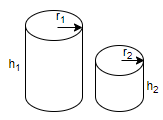Answer
405.3k+ views
Hint: We will first assume two cylinders having different radius ${{r}_{1}}$ and ${{r}_{2}}$ respectively and the heights of the cylinders are ${{h}_{1}}$ and ${{h}_{2}}$. But in the problem, they have mentioned that the heights of the two cylinders are in $2:1$ ratio. From this ration we will obtain a relation between the heights $\left( {{h}_{1}},{{h}_{2}} \right)$ of the cylinders. In the problem they have also mentioned that the volumes of the two cylinders are equal, so we will calculate the volume of two cylinders having radius ${{r}_{1}},{{r}_{2}}$ and height ${{h}_{1}},{{h}_{2}}$ respectively by using the formula volume $\left( V \right)=\pi {{r}^{2}}h$and then we will equate the both the values. In this equation we will use our known relation between heights to calculate the ratio of radii.
Complete step by step answer:
Given that, Two cylinders of equal volume have their heights in the ratio $2:1$.
Let us consider the figure as below and take the terms as

Radius of the first cylinder is ${{r}_{1}}$,
Radius of the second cylinder is ${{r}_{2}}$,
Height of the first cylinder is ${{h}_{1}}$,
Height of the second cylinder is ${{h}_{2}}$.
$\therefore $ Volume of first cylinder is ${{V}_{1}}=\pi {{r}_{1}}^{2}{{h}_{1}}$.
$\Rightarrow $ Volume of second cylinder is ${{V}_{2}}=\pi {{r}_{2}}^{2}{{h}_{2}}$.
But we have the volumes of both the cylinders as same.
$\begin{align}
& \therefore {{V}_{1}}={{V}_{2}} \\
& \Rightarrow \pi {{r}_{1}}^{2}{{h}_{1}}=\pi {{r}_{2}}^{2}{{h}_{2}} \\
\end{align}$
Cancelling the term $\pi $ which is on both sides and rearranging the above equation as radii of both cylinders at one place, then we will have
$\begin{align}
& \dfrac{r_{1}^{2}}{r_{2}^{2}}=\dfrac{{{h}_{2}}}{{{h}_{1}}} \\
& \Rightarrow \dfrac{{{r}_{1}}}{{{r}_{2}}}=\sqrt{\dfrac{{{h}_{2}}}{{{h}_{1}}}}...\left( \text{i} \right) \\
\end{align}$
Given that, the heights of the cylinders are in the ratio $2:1$.
$\begin{align}
& \therefore {{h}_{1}}:{{h}_{2}}=2:1 \\
& \Rightarrow \dfrac{{{h}_{1}}}{{{h}_{2}}}=\dfrac{2}{1} \\
& \Rightarrow {{h}_{1}}=2{{h}_{2}} \\
\end{align}$
Using the above value in equation $\left( \text{i} \right)$, then we will have
$\begin{align}
& \dfrac{{{r}_{1}}}{{{r}_{2}}}=\sqrt{\dfrac{{{h}_{2}}}{2{{h}_{2}}}} \\
& \Rightarrow \dfrac{{{r}_{1}}}{{{r}_{2}}}=\sqrt{\dfrac{1}{2}} \\
& \Rightarrow \dfrac{{{r}_{1}}}{{{r}_{2}}}=\dfrac{1}{\sqrt{2}} \\
\end{align}$
$\therefore $ Ratio of radii of the two cylinders is $1:\sqrt{2}$.
Note: Sometimes they may give one cylinder and one cone instead of two cylinders, then we will use the volume of cone formula as ${{V}_{c}}=\dfrac{1}{3}\pi {{r}^{2}}h$ and do the process according to the given conditions. So, we must be well versed with the formulas. Some students might make mistakes in taking the ratios, this might lead to the choice of the wrong option.
Complete step by step answer:
Given that, Two cylinders of equal volume have their heights in the ratio $2:1$.
Let us consider the figure as below and take the terms as

Radius of the first cylinder is ${{r}_{1}}$,
Radius of the second cylinder is ${{r}_{2}}$,
Height of the first cylinder is ${{h}_{1}}$,
Height of the second cylinder is ${{h}_{2}}$.
$\therefore $ Volume of first cylinder is ${{V}_{1}}=\pi {{r}_{1}}^{2}{{h}_{1}}$.
$\Rightarrow $ Volume of second cylinder is ${{V}_{2}}=\pi {{r}_{2}}^{2}{{h}_{2}}$.
But we have the volumes of both the cylinders as same.
$\begin{align}
& \therefore {{V}_{1}}={{V}_{2}} \\
& \Rightarrow \pi {{r}_{1}}^{2}{{h}_{1}}=\pi {{r}_{2}}^{2}{{h}_{2}} \\
\end{align}$
Cancelling the term $\pi $ which is on both sides and rearranging the above equation as radii of both cylinders at one place, then we will have
$\begin{align}
& \dfrac{r_{1}^{2}}{r_{2}^{2}}=\dfrac{{{h}_{2}}}{{{h}_{1}}} \\
& \Rightarrow \dfrac{{{r}_{1}}}{{{r}_{2}}}=\sqrt{\dfrac{{{h}_{2}}}{{{h}_{1}}}}...\left( \text{i} \right) \\
\end{align}$
Given that, the heights of the cylinders are in the ratio $2:1$.
$\begin{align}
& \therefore {{h}_{1}}:{{h}_{2}}=2:1 \\
& \Rightarrow \dfrac{{{h}_{1}}}{{{h}_{2}}}=\dfrac{2}{1} \\
& \Rightarrow {{h}_{1}}=2{{h}_{2}} \\
\end{align}$
Using the above value in equation $\left( \text{i} \right)$, then we will have
$\begin{align}
& \dfrac{{{r}_{1}}}{{{r}_{2}}}=\sqrt{\dfrac{{{h}_{2}}}{2{{h}_{2}}}} \\
& \Rightarrow \dfrac{{{r}_{1}}}{{{r}_{2}}}=\sqrt{\dfrac{1}{2}} \\
& \Rightarrow \dfrac{{{r}_{1}}}{{{r}_{2}}}=\dfrac{1}{\sqrt{2}} \\
\end{align}$
$\therefore $ Ratio of radii of the two cylinders is $1:\sqrt{2}$.
Note: Sometimes they may give one cylinder and one cone instead of two cylinders, then we will use the volume of cone formula as ${{V}_{c}}=\dfrac{1}{3}\pi {{r}^{2}}h$ and do the process according to the given conditions. So, we must be well versed with the formulas. Some students might make mistakes in taking the ratios, this might lead to the choice of the wrong option.
Recently Updated Pages
How many sigma and pi bonds are present in HCequiv class 11 chemistry CBSE

Why Are Noble Gases NonReactive class 11 chemistry CBSE

Let X and Y be the sets of all positive divisors of class 11 maths CBSE

Let x and y be 2 real numbers which satisfy the equations class 11 maths CBSE

Let x 4log 2sqrt 9k 1 + 7 and y dfrac132log 2sqrt5 class 11 maths CBSE

Let x22ax+b20 and x22bx+a20 be two equations Then the class 11 maths CBSE

Trending doubts
Fill the blanks with the suitable prepositions 1 The class 9 english CBSE

At which age domestication of animals started A Neolithic class 11 social science CBSE

Which are the Top 10 Largest Countries of the World?

Give 10 examples for herbs , shrubs , climbers , creepers

Difference between Prokaryotic cell and Eukaryotic class 11 biology CBSE

Difference Between Plant Cell and Animal Cell

Write a letter to the principal requesting him to grant class 10 english CBSE

Change the following sentences into negative and interrogative class 10 english CBSE

Fill in the blanks A 1 lakh ten thousand B 1 million class 9 maths CBSE



